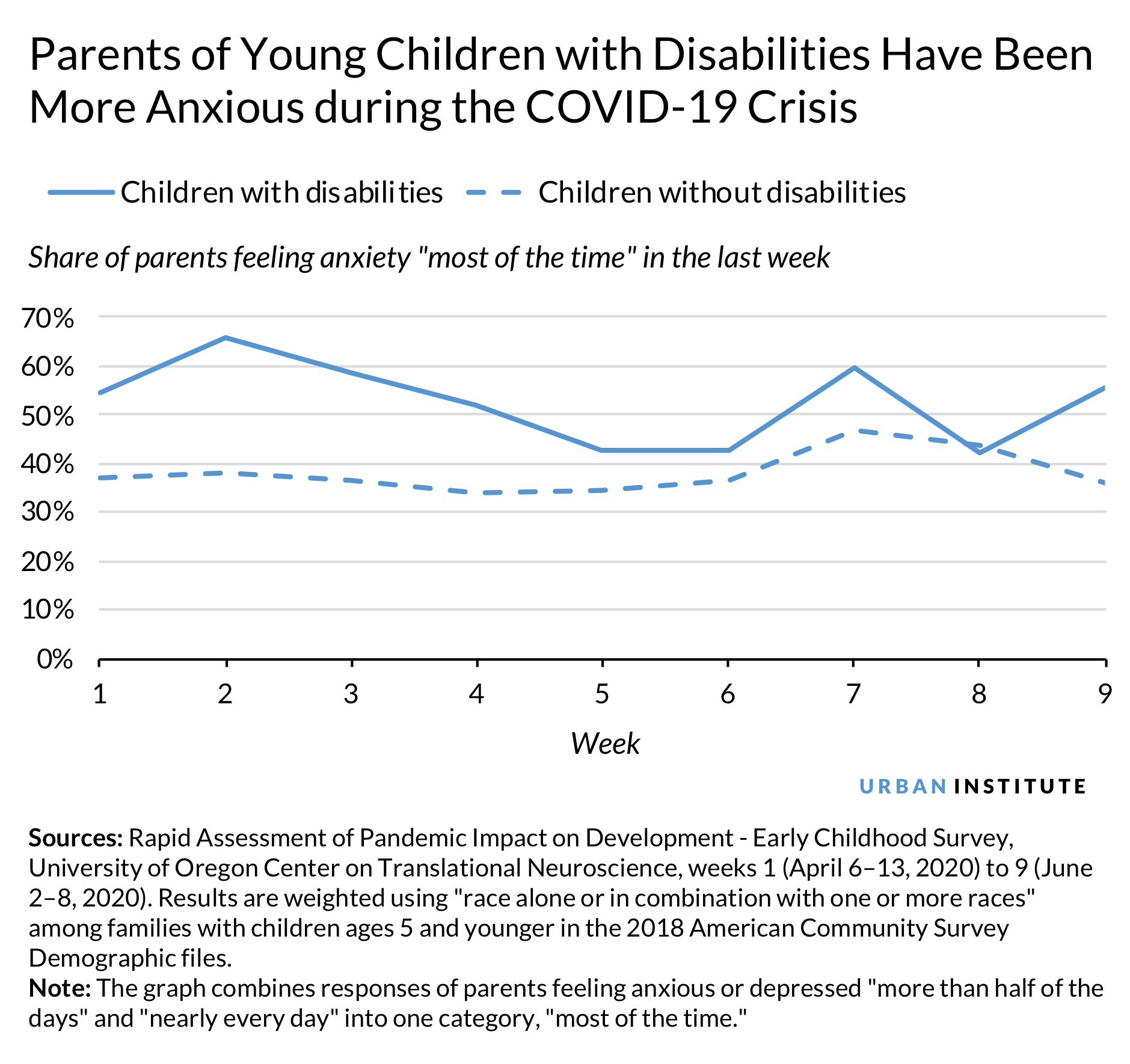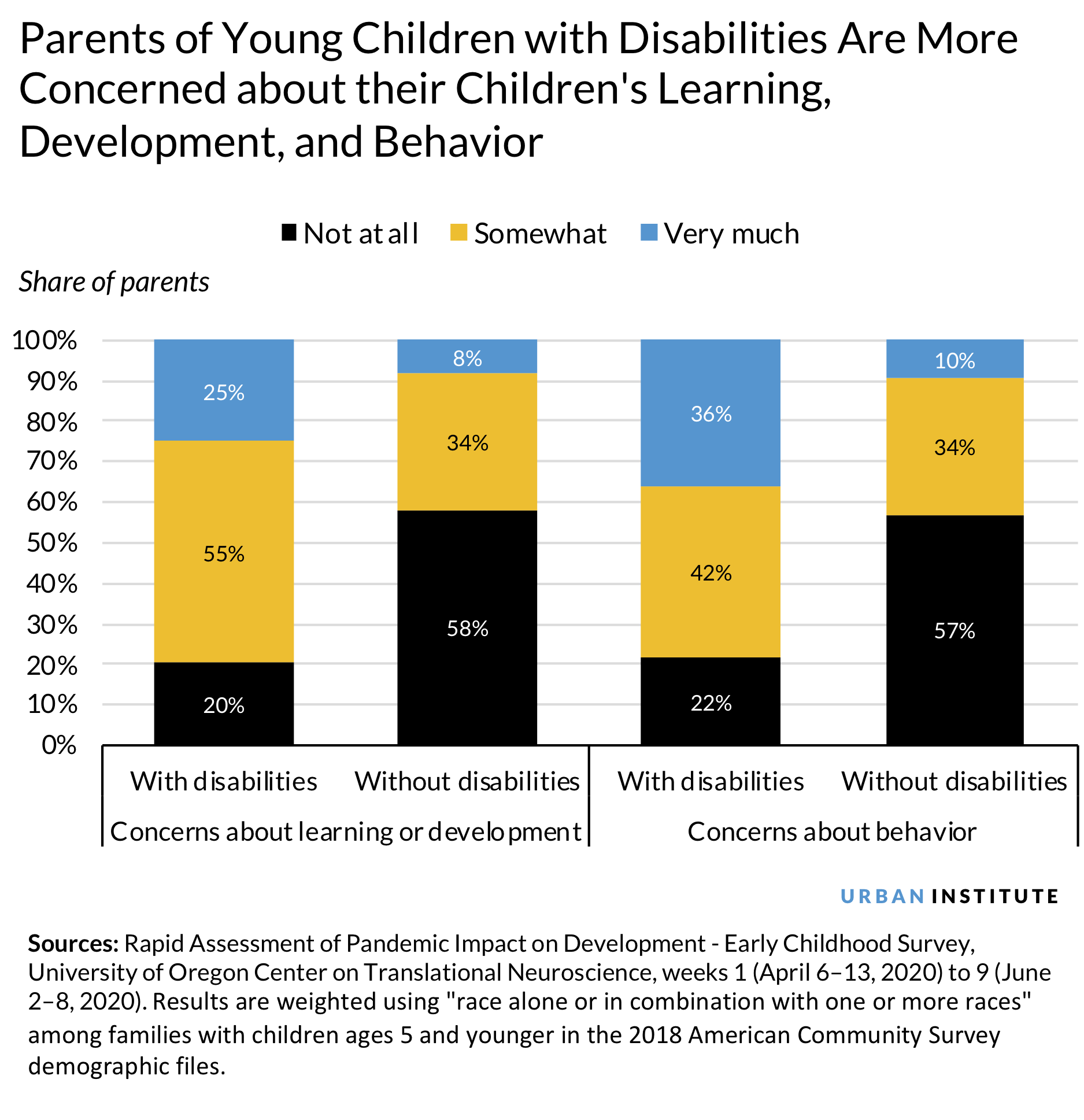
<p>Maskot/Getty Images</p>
Since schools and child care programs closed and stay-at-home orders went into effect, states and providers have been grappling with how to support young children with disabilities in a virtual environment. What has not been talked about, however, is how to support the parents of these young children, who, the data show, are generally experiencing higher rates of stress, depression, and anxiety than other parents.


These findings come from a new survey from the University of Oregon’s Center on Translational Neuroscience. The Rapid Assessment of Pandemic Impact on Development (RAPID) - Early Childhood Survey is a weekly early childhood family well-being survey designed to gather essential information regarding the needs, health promoting behaviors, and well-being of families with children ages 5 and younger during the COVID-19 outbreak in the United States. To help put the RAPID data in context for policy, we spoke with Urban Institute researcher Laudan Aron about the needs of families of children with disabilities and policy solutions that could help meet them.
What we know about families of children with disabilities
To understand the pandemic’s effects on children with disabilities and their families, it is important to understand who these children are. In 2017, 388,694 children ages 2 and younger received services through Part C of the Individuals with Disabilities Act (IDEA), and 773,595 children ages 3 to 5 received services through IDEA Part B. (These numbers reflect children identified, deemed eligible, and served through the program and are therefore underestimates of the true number of young children with developmental delays or disabilities. They also reflect variability in eligibility criteria and diagnosis categories across states.)
Among children ages 3 to 5 identified as having a disability, more than 40 percent received services for a speech or language impairment, 37 percent had a developmental delay, and 11 percent were diagnosed with autism. These children generally received special education services in early childhood education programs. Infants and toddlers with special needs primarily received early intervention services in their home.
Whether at home or in child care programs and schools, many services have been disrupted by the pandemic. Though federal guidance (PDF) indicates children by and large should continue receiving services under IDEA, some service providers say they have been given few tools to meaningfully administer services virtually, likely contributing to parental stress. The RAPID data show a threefold increase in uncertainty about access to early intervention services during the pandemic (17 percent of parents of children with disabilities surveyed, compared with 5 percent who said they were unsure about access before the pandemic).
With that uncertainty comes concerns about children’s development. Compared with other parents, parents of children with a disability are more likely to be concerned about their child’s learning, development, and behavior.

Parental stress is a concern because parents and caregivers provide the foundation for young children’s healthy development, particularly when children might not have access to their usual sources of support. And, as the Oregon team discusses, a child’s mental health is closely linked to their caregiver’s mental health.
What policy can do
To support young children with disabilities, policy solutions need to focus not just on getting services to children but also on getting services to families. Policymakers will also need to recognize that stress, depression, and anxiety will not end when children return to school or child care but likely will have long-lasting effects that deserve attention beyond the pandemic. Policy solutions that address both short- and long-term needs include the following:
- Alleviating uncertainties. Though the US Department of Education has confirmed that children with disabilities should continue receiving services during the pandemic, confusion remains. Many families and providers are unclear about their roles, and even the best-intentioned families may have difficulty meeting the requirements in children’s plans because of limited time and resources. Adding to the uncertainty, Secretary Betsy DeVos has requested a waiver under the CARES Act to ensure that children eligible to move from Part C to Part B services at age 3 do not lose access to services during the pandemic, but this waiver has not yet been approved by Congress. Resolving these uncertainties, and providing needed supports, can help reduce parents’ stress.
- Expanding home visiting programs (even if they’re virtual). Home visiting benefits both children and caregivers, but many families who could benefit still don’t receive services. Congress could expand the program, which has been shown to generate positive two-generational effects, and pair home visiting with IDEA Part C and Part B services for maximum impact.
- Increasing support for community-based health centers. These publicly funded institutions, which broadly focus on the social determinants of health, provide a range of medical, social, and educational services to marginalized communities and can be key sources of support for low-income families that include a child with a disability. Many of these centers, however, have struggled during the pandemic. Ensuring community-based health centers have the financial support they need to weather this period and meet future demand ensures families of children with disabilities can access needed mental health, behavioral, and academic support after the pandemic.
- Investing in telehealth (PDF) services for young children with disabilities. Although there are limits to telehealth, it can expand access to care during the pandemic. Anecdotally, some providers report that virtual sessions with children with disabilities have helped engage families. But access barriers—from broadband to translation and interpretation services—remain. Policymakers can enhance services with additional public funding, ensuring families and service providers have the technological access and training needed to make telehealth work.
- Expanding safety net supports like Pandemic Electronic Benefits Transfer (EBT). In the RAPID data, 29 percent of families of children with disabilities reported major or extreme financial problems, compared with 19 percent of other families with young children. Given that families of children with disabilities are likely to experience more stress if they are low-income, policymakers can help mitigate the stress by alleviating financial instability through programs like Pandemic EBT.
- Planning for recovery. Without schools, child care programs, and in-person early intervention providers, the pipeline to IDEA supports is frozen. Thousands of children may miss out on referrals, diagnoses, and special education services they would have received otherwise. Careful planning for swift recovery, including outreach to parents, can help mitigate the stresses of reopening once health and safety conditions improve and families begin moving beyond COVID-19.
Let’s build a future where everyone, everywhere has the opportunity and power to thrive
Urban is more determined than ever to partner with changemakers to unlock opportunities that give people across the country a fair shot at reaching their fullest potential. Invest in Urban to power this type of work.